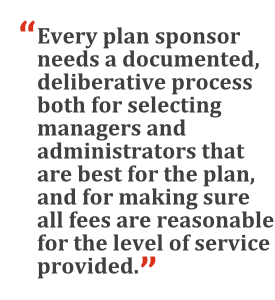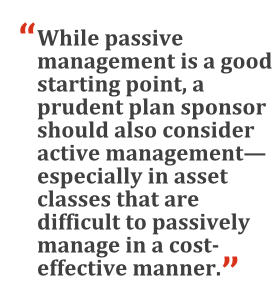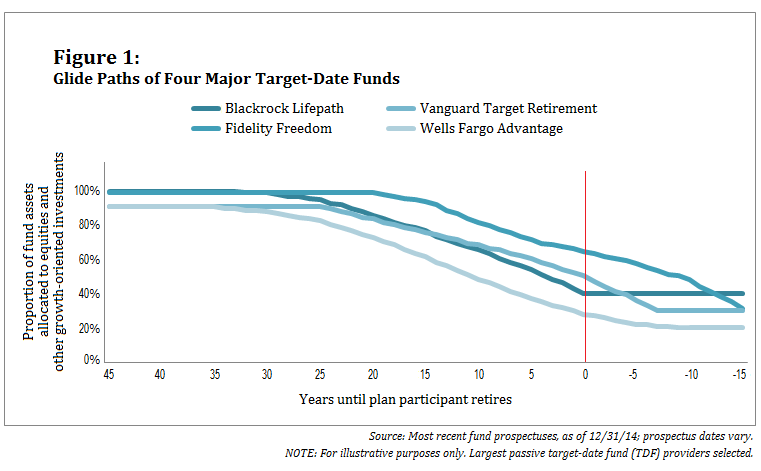 High-profile court cases that pit participants in defined-contribution retirement plans against the plans' sponsors have dominated news headlines lately. Participants in some plans have sued, claiming their plan's sponsor violated its fiduciary duty by offering investment options that carry excessive fees. If you sponsor a defined-contribution plan, the implications of cases like Tibble v. Edison and Tussey v. ABB might have you feeling a bit of pressure. You wouldn't be alone.
High-profile court cases that pit participants in defined-contribution retirement plans against the plans' sponsors have dominated news headlines lately. Participants in some plans have sued, claiming their plan's sponsor violated its fiduciary duty by offering investment options that carry excessive fees. If you sponsor a defined-contribution plan, the implications of cases like Tibble v. Edison and Tussey v. ABB might have you feeling a bit of pressure. You wouldn't be alone.
Heightened scrutiny on defined-contribution plan fees has led some sponsors to decide to move their plan investments to lower-cost passive options. The rationale is that if courts have decided high fees are bad, then funds with the lowest possible overall cost must be good. Unfortunately, things are not that simple.
At the core of several court cases is ERISA Section 404(a)(1), known as the “prudent investor standard.” It specifies that a plan fiduciary has a duty to act solely in the interests of participants and beneficiaries, defray reasonable expenses of administering the plan, and act in the same manner that a prudent person would in the same circumstances. These provisions do not suggest that the plan's fees must be the lowest on an absolute basis, just that they must be reasonable.
Further complicating the question of excessive fees, courts have found that a fiduciary is failing to act solely in the best interests of plan participants and beneficiaries if the fiduciary acts out of concern for its own liability. In Tatum v. RJR, the court found that the decision to divest the RJ Reynolds pension plan of Nabisco stock was for the purpose of reducing the liability of the company and thus a violation of ERISA.
Picking an all-passive lineup in order to avoid lawsuits is clearly a decision that is not focused solely on what's in the participants' best interests. So, before making strategic changes to their defined-contribution plan menu, plan sponsors need to take into consideration the lessons offered by several recent court decisions.
What Can You Learn from the Litigation?
In several recent cases, the courts have clarified that fiduciaries don't have an obligation to simply select the cheapest option.
In Tibble v. Edison, the underlying question was whether fiduciaries of the plan had chosen the proper share class for certain mutual funds offered. The Supreme Court ruled in favor of plan participants who claimed Edison International violated its fiduciary duty by offering participants mutual funds that were more expensive than other materially equivalent funds available on the market. The main lesson to be learned from this ruling is that a fiduciary has an obligation to monitor plan investments and fees on an ongoing basis, even after a fund is selected.
 In Hecker v. Deere, the court ruled that ERISA does not require fiduciaries to scour the market to find and offer the cheapest possible fund (which might create other problems). What plan sponsors must do is make sure the options they offer are reasonable. And the recently filed Bell v. Anthem and White v. Chevron cases show that even a sponsor which primarily uses index funds is not immune from getting sued over the issue of reasonable fees.
In Hecker v. Deere, the court ruled that ERISA does not require fiduciaries to scour the market to find and offer the cheapest possible fund (which might create other problems). What plan sponsors must do is make sure the options they offer are reasonable. And the recently filed Bell v. Anthem and White v. Chevron cases show that even a sponsor which primarily uses index funds is not immune from getting sued over the issue of reasonable fees.
These cases demonstrate that defined-contribution plan fiduciaries have an obligation under the law to make prudent and reasoned decisions in the best interests of the plan's participants based on the evaluation and subsequent monitoring of funds. This means that every plan sponsor needs a documented, deliberative process both for selecting managers and administrators that the plan sponsor thinks are best for the plan, and for making sure all fees are reasonable for the level of service provided, including fees paid separately and through revenue sharing.
Some plan sponsors are addressing this fiduciary duty either by hiring consultants who can advise on the best investment options, or by outsourcing investment management functions to an ERISA section 3(38) investment manager—one with the power to manage the selection, monitoring, and (if necessary) replacement of the plan's fund managers.
When a plan sponsor designates an outsourcer to carry out investment responsibilities, the outsourcer becomes liable for those activities under ERISA. The sponsor retains liability for the prudent selection and ongoing monitoring of the outsourcer.
Going Passive: Investment-Related Issues You Need to Consider
Some sponsors pick passive investments, which make investment choices based on an external index and generally seek to minimize investing fees. Plan sponsors may believe that passive investments reduce their fiduciary risk and due diligence obligations. But the truth is that “going passive” involves several active decisions, and meaningful due diligence requirements remain around each of these decisions.
Sponsors need to have documented processes showing that they have reviewed and understand:

The index provider's organization. Who is providing index data for the fund(s) you are offering to defined-contribution plan participants? Participants invest with money managers (not index providers), but the plan sponsor still needs to make sure the index provider comes from a strong organization that has experience and expertise in creating indexes.
Plan sponsors can start by asking fund managers about their investment rationale for the index provider, including how the provider compares with others in terms of fees and exposures. It is also important to understand the research capabilities, technology infrastructure, and history of the index provider. If the fund manager does not provide satisfactory answers, plan sponsors can take their questions directly to the index provider.

The index provider's methodology. For passive options, the investment experience is driven, almost completely, by the index provider's methodology. Therefore, it is crucial for the defined-contribution plan sponsor selecting an index fund to understand the index's underlying methodology. This includes verifying that the index exposures match the plan sponsor's desired exposures.
There are several different methodologies across index providers, which can lead to different types of exposures. For example, the calendar-year returns of the S&P 500 Index differ from those of the FTSE Russell 1000 Index, despite both being good proxies for U.S. large-cap equity. Between 1998 and 2014, the differential return was almost 300 basis points in some calendar years. In fixed income, the Barclays U.S. Aggregate Bond Index has increased its allocation to low-yielding government securities over the last five years. If interest rates increase, this exposure could leave participants unguarded.

Quality of implementation by the passive-fund manager. More goes into managing a passive fund than you might think. There are rules about sampling (or not), rebalancing, pricing, and market timing. The way these rules are designed and implemented can change how closely the fund tracks an index. That is why tracking “error,” in addition to cost and performance history, is a key indicator for evaluating passive investments.
One source of tracking error may be the index manager's replication method. Funds do not necessarily purchase every security in an index. They may choose a sample designed to represent the whole instead. Other areas that can affect tracking and performance are the sophistication of the quantitative tools the fund uses, its trading practices, and the amount and timing of cross-trading.
As with the management of any investment option, plan sponsors also need to be comfortable with the team responsible for managing implementation at the index fund.

The feasibility and costs of replicating the index. Some indexes can be replicated easily; these are typically indexes that track asset classes which are highly liquid and publicly traded. But some less-liquid markets, such as high-yield bonds, may present substantial management and implementation costs. They may also present a high likelihood of tracking error because a fund manager is unlikely to be able to perfectly match the fund's investments to the index portfolio. And some markets, such as private real estate, can't be replicated in an index at all.
Plan sponsors that opt for an all-passive fund lineup should be aware that they may be preventing plan participants from accessing certain asset classes within the plan, because those asset classes lack quality index funds. Returning to the decision in Hecker v. Deere, the lesson for plan sponsors is to focus on the value of fund options, not just fees. Asset classes that are more efficient, with higher analyst coverage, may make good candidates for passive management. Less-efficient classes with lower analyst coverage, such as small cap equities, emerging markets equities, and real assets, can be attractive for active management.
Whatever the final decision on passive and active options, plan sponsors need to base their choice on a belief about what is best for their participants and document the process and rationale for arriving at their decision.

The fees charged by the passive-fund provider. Several passive-fund managers provide very similar products yet have different fee structures. A key element of the defined-contribution plan sponsor's fiduciary duty is to ensure that plan participants are paying the lowest fees possible, given the size of assets in the plan. This was raised in the recent White v. Chevron lawsuit.
Two important questions to ask are the following: Does the fund you selected for participants have the cheapest share class available to your plan? How do mutual funds compare with collective investment trusts?
A plan sponsor is responsible for the ongoing review of fees and costs, and while the courts have not defined exactly what “ongoing” means, it makes sense to review a plan at least annually.

Might active-management opportunities be more prudent? While passive management is a good starting point, a prudent plan sponsor should also consider active management—especially in situations involving asset classes that are difficult to passively manage in a cost-effective manner. Asking questions like this in an annual review can help demonstrate a “conscientious and diligent process” for reaching prudent investing decisions.
Keep in mind that low fees don't necessarily translate into better outcomes for participants. For example, in an institutionally run target-date fund that mixes active and passive investments, it would be reasonable to expect an extra 50 basis points per year in performance, net of fees, compared with passive counterparts. Russell Investments' analysis finds that this difference could generate up to seven years of additional spending in retirement for a participant who saved and invested over a 40-year working career.
Additional Review for Passive Target-Date Funds

Glide path methodology. The managers of a target-date fund (TDF) decide when and where to invest the fund's assets. These decisions are active, even if they choose all passive investments that individually track relevant indexes, such as the S&P 500 Index and Barclays U.S. Aggregate Bond Index.
A TDF's “glide path” shows how it changes the mix of growth-oriented and income-oriented investments as the fund approaches the target retirement date. The glide paths of four major “passive” target-date providers show clearly that several active decisions are embedded in the design of each TDF (see Figure 1, below). These include when the glide path starts to slope—i.e., when the fund starts to allocate less of the portfolio to growth-oriented investments—as well as the steepness of the slope, how much risk the plan participant is taking at retirement, and whether the glide path remains flat in retirement. All of these decisions influence participants' potential outcomes and experiences.


Asset allocation. It's important to understand which asset classes the TDF managers choose and when they make changes to these allocations. If a passive TDF manager omits certain asset classes that cannot be cost-effectively managed passively, that exclusion is an active decision that may increase volatility or reduce return expectations.
 The plan sponsor also needs to consider how the TDF manager makes allocations across the asset classes. For example, how much of the equity allocation is in U.S. securities? Geographic diversification is particularly important for TDFs because they are designed to manage all of a plan participant's assets. A concentrated allocation to any particular asset class or region could lead to higher portfolio volatility, while a more globally focused allocation could potentially lead to a smoother ride, which is important to many participants saving for retirement.
The plan sponsor also needs to consider how the TDF manager makes allocations across the asset classes. For example, how much of the equity allocation is in U.S. securities? Geographic diversification is particularly important for TDFs because they are designed to manage all of a plan participant's assets. A concentrated allocation to any particular asset class or region could lead to higher portfolio volatility, while a more globally focused allocation could potentially lead to a smoother ride, which is important to many participants saving for retirement.
Sponsors might consider a TDF series that uses actively managed funds for asset classes with the greatest potential for adding value going forward, but also uses passively managed funds for efficient asset classes like large-cap U.S. equities. This approach enables the plan sponsor to control overall fund costs while bringing participants a diversified combination of potential return sources—including some asset classes (e.g., real assets) that are typically more expensive.
Making the Best-Informed Decisions for Plan Participants
Defined-contribution plan sponsors have a big responsibility. They should make decisions based exclusively on which investment choices they think are best for their plan's participants, while ensuring compliance with legal and regulatory requirements. In particular, I encourage plan sponsors to:
- focus on each fund's value, not just the level of fees;
- avoid taking what seems to be the path of least resistance—i.e., going all-passive in the belief that doing so provides some fiduciary protection;
- document the rationale behind each decision; and
- get expert advice and/or outsource to a trusted provider if your organization doesn't have the right investment expertise in-house.
Ultimately, making decisions that help plan participants reach their retirement-income goals is in the best interests of both the participants and the plan sponsor. Doing so may also help keep your organization's name out of the headlines.
————————————
 Josh Cohen is managing director for defined contribution with Russell Investments, responsible for the leadership, strategic direction, and growth of the U.S. defined contribution business. He is an executive committee member and chair of the retirement research board of the Defined Contribution Institutional Investment Association (DCIIA), a member of the Board of Trustees of the Employee Benefit Research Institute (EBRI), and recently served on the Department of Labor's ERISA Advisory Council.
Josh Cohen is managing director for defined contribution with Russell Investments, responsible for the leadership, strategic direction, and growth of the U.S. defined contribution business. He is an executive committee member and chair of the retirement research board of the Defined Contribution Institutional Investment Association (DCIIA), a member of the Board of Trustees of the Employee Benefit Research Institute (EBRI), and recently served on the Department of Labor's ERISA Advisory Council.
The opinions expressed in this material are not necessarily those held by Russell Investments, its affiliates or subsidiaries. While all material is deemed to be reliable, accuracy and completeness cannot be guaranteed. The information, analysis, and opinions expressed herein are for general information only and are not intended to provide specific advice or recommendations for any individual or entity.
AI-24295
© Touchpoint Markets, All Rights Reserved. Request academic re-use from www.copyright.com. All other uses, submit a request to [email protected]. For more inforrmation visit Asset & Logo Licensing.



